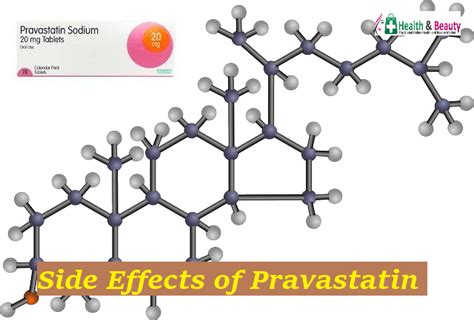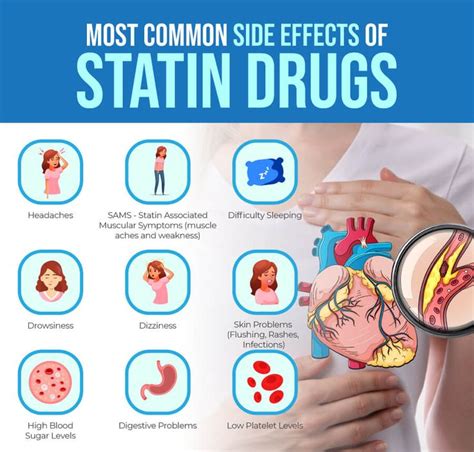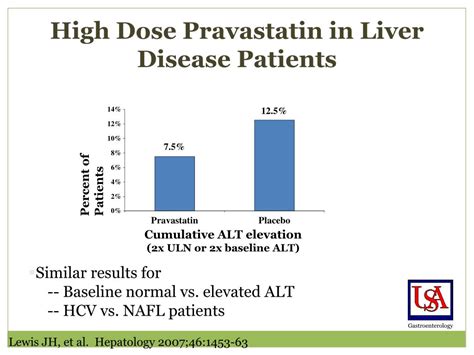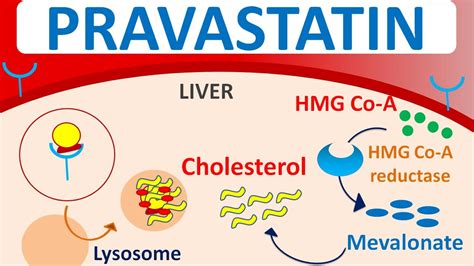Intro
Discover the potential risks of Pravastatin, a statin medication, including common side effects like muscle pain, liver damage, and increased blood sugar, to make informed decisions about your cholesterol treatment and manage potential health complications.
The importance of understanding the potential side effects of medications cannot be overstated, especially when it comes to statins like pravastatin. Pravastatin is a commonly prescribed statin used to lower cholesterol levels and reduce the risk of cardiovascular disease. While it is generally considered safe and effective, like all medications, it can cause side effects in some individuals. Being aware of these potential side effects is crucial for patients to make informed decisions about their treatment and to seek medical attention if necessary.
Pravastatin, like other statins, works by inhibiting the enzyme HMG-CoA reductase, which plays a key role in the production of cholesterol in the liver. By reducing cholesterol production, pravastatin helps to lower the levels of "bad" LDL cholesterol and triglycerides in the blood, while also increasing the levels of "good" HDL cholesterol. This can significantly reduce the risk of heart attacks, strokes, and other cardiovascular events. However, the benefits of pravastatin must be weighed against the potential risks, including its side effects.
Understanding the side effects of pravastatin is essential for managing patient care effectively. Side effects can range from mild and temporary to severe and potentially life-threatening. While not everyone who takes pravastatin will experience side effects, being informed about the possibilities can help patients recognize when something is amiss and seek medical help promptly. Healthcare providers also benefit from this knowledge, as it enables them to monitor their patients more effectively and adjust treatment plans as needed.
Common Pravastatin Side Effects

Common side effects of pravastatin are generally mild and may include headaches, nausea, vomiting, diarrhea, and abdominal pain. These side effects often resolve on their own and do not require medical attention unless they are severe or persistent. However, it's essential to discuss any side effects with a healthcare provider, as they can sometimes be a sign of a more serious issue or indicate that the dosage needs to be adjusted.
Less Common but Serious Side Effects
In addition to the common side effects, pravastatin can also cause less common but more serious side effects. These include muscle pain or weakness, which can be a sign of muscle damage (myopathy), and liver damage, indicated by elevated liver enzymes. While these side effects are less common, they are more severe and require immediate medical attention.Statins and Muscle Pain

Muscle pain or myalgia is one of the most common side effects associated with statin use, including pravastatin. This can range from mild muscle soreness to severe muscle damage (rhabdomyolysis), although the latter is extremely rare. For most people, muscle pain associated with statin use is mild and may be managed with over-the-counter pain relievers or by adjusting the statin dosage. However, if the pain is severe or is accompanied by other symptoms such as dark urine or fever, medical help should be sought immediately.
Managing Muscle Pain
Managing muscle pain while on pravastatin involves a combination of lifestyle modifications and, in some cases, medical interventions. Staying hydrated, engaging in regular but not excessive physical activity, and considering alternative statins or adjusting the dosage under the guidance of a healthcare provider can help alleviate muscle pain. Vitamin D supplements may also be beneficial, as some research suggests a link between vitamin D deficiency and muscle pain in statin users.Pravastatin and Liver Damage

Liver damage is another potential side effect of pravastatin, although it is relatively rare. Statins, including pravastatin, can cause elevations in liver enzymes, which are indicators of liver health. In most cases, these elevations are mild and do not lead to serious liver damage. However, regular monitoring of liver enzymes is recommended for individuals taking pravastatin to quickly identify any potential issues.
Monitoring Liver Health
Monitoring liver health while on pravastatin typically involves regular blood tests to check liver enzyme levels. These tests can help identify any abnormalities early on, allowing for prompt intervention if necessary. In some cases, this might involve adjusting the dosage of pravastatin or switching to a different medication. It's also important for patients to be aware of the signs of liver damage, such as jaundice, dark urine, or severe fatigue, and to seek medical attention if they experience any of these symptoms.Other Potential Side Effects

In addition to muscle pain and liver damage, pravastatin can cause other side effects, though these are less common. These may include cognitive impairment, increased risk of diabetes, and peripheral neuropathy. Cognitive impairment, such as memory loss or confusion, has been reported by some statin users, although the evidence linking statins directly to cognitive decline is not conclusive. An increased risk of developing type 2 diabetes has also been associated with statin use, particularly in individuals with risk factors for diabetes. Peripheral neuropathy, characterized by numbness or tingling in the hands and feet, is another potential side effect, though it is rare.
Statins and Cognitive Function
The relationship between statins and cognitive function is complex and not fully understood. While some patients report cognitive impairment, such as memory problems or difficulty concentrating, the scientific evidence does not definitively support a causal link between statin use and cognitive decline. However, patients who experience any cognitive changes while on pravastatin should discuss these with their healthcare provider, as there may be other underlying causes that need to be addressed.Pravastatin Interactions

Pravastatin, like other medications, can interact with other drugs, potentially leading to adverse effects. It's essential for patients to inform their healthcare providers about all the medications they are taking, including over-the-counter drugs and supplements, to minimize the risk of interactions. Certain medications, such as gemfibrozil, cyclosporine, and erythromycin, can increase the risk of muscle damage when taken with pravastatin. Grapefruit and grapefruit juice can also interact with pravastatin, increasing its levels in the blood and potentially leading to side effects.
Managing Interactions
Managing interactions with pravastatin involves careful monitoring and, in some cases, adjusting the medications or their dosages. Patients should never start, stop, or change the dosage of any medication, including pravastatin, without consulting their healthcare provider. Regular reviews of medication lists and open communication about any changes can help prevent adverse interactions and ensure safe treatment.Conclusion and Next Steps

In conclusion, while pravastatin is an effective medication for lowering cholesterol and reducing cardiovascular risk, it is not without potential side effects. Understanding these side effects, from common issues like muscle pain to more serious concerns like liver damage, is crucial for patients and healthcare providers alike. By being informed and proactive, individuals can manage their treatment safely and effectively, minimizing the risks associated with pravastatin and maximizing its benefits.
Patients who are taking or considering taking pravastatin should discuss any concerns or questions they have with their healthcare provider. This includes any side effects they are experiencing, as well as any other medications or supplements they are taking. Regular follow-up appointments can help monitor for any potential issues and adjust the treatment plan as necessary.
For those interested in learning more about pravastatin and its side effects, there are numerous resources available, including patient information leaflets, online health forums, and professional medical organizations. Staying informed and engaged in one's healthcare can make a significant difference in managing treatment effectively and maintaining overall health.
We invite readers to share their experiences or ask questions about pravastatin and its side effects in the comments section below. Your input can help others better understand this medication and its potential impacts. Additionally, if you found this article informative, please consider sharing it with others who might benefit from this information.
What are the most common side effects of pravastatin?
+The most common side effects of pravastatin include headaches, nausea, vomiting, diarrhea, and abdominal pain. These side effects are generally mild and temporary.
Can pravastatin cause muscle damage?
+Yes, pravastatin can cause muscle pain or weakness, which can be a sign of muscle damage (myopathy). Although rare, it's essential to seek medical attention if you experience severe muscle pain or other symptoms of muscle damage.
How often should I have my liver enzymes checked while taking pravastatin?
+Regular monitoring of liver enzymes is recommended for individuals taking pravastatin. The frequency of these tests can vary depending on individual risk factors and should be determined by your healthcare provider.
